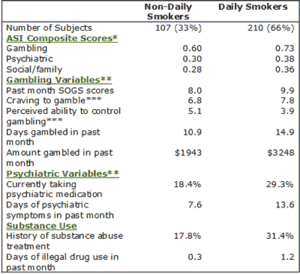The Wager, Volume 8(5) – The Smoking Gun
Among substance abusers, smokers have more severe substance abuse symptoms and comorbid psychosocial problems than non-smokers (Roll, Higgins, Budney, Bickel, & Badger, 1996). In a recent study, Petry and Oncken (2002) examined whether a similar relationship exists for pathological gamblers. This week’s WAGER presents the results of their study.
Petry and Oncken studied 345 consecutive admissions to a gambling treatment program study between August 1998 and July 2000. At intake to the treatment program, these subjects completed the Addictions Severity Index (McLellan, Luborsky, Cacciola, & Griffith, 1985), the South Oaks Gambling Screen (Lesieur & Blume, 1987), and 10-point Likert scale questions measuring their craving to gamble and perceived ability to control gambling. The researchers excluded former daily smokers (21 subjects) and seven subjects with missing data on smoking behavior from their analysis. Petry and Oncken compared the demographics and current gambling and psychosocial problems of daily smokers to those of gamblers who were never daily smokers.
Table 1 displays the significant differences between daily and non-daily smokers. Daily smokers exhibited more severe gambling, social/family, and psychiatric problems as measured by the Addiction Severity Index. When gambling behavior was examined in greater detail, daily smokers had higher SOGS scores, stronger cravings to gamble, spent more money gambling and had gambled five days more each month on average than non-daily smokers. Non-daily smokers had greater belief in their ability to control their gambling behavior. Finally, daily smokers were more likely to have comorbid psychiatric or substance abuse problems. Almost a third of daily smokers were currently taking psychiatric medications compared to 18% of non-daily smokers. Daily smokers experienced a greater number of days with psychiatric symptoms in the past month (mean days = 13.6 versus 7.6). Similarly, a third of daily smokers had a history of substance abuse treatment, compared to only 17.8% of non-daily smokers; daily smokers also currently use illegal drugs more often than non-daily smokers.
Table 1. Significant differences (p>.05) in characteristics between non-daily and daily smokers entering gambling treatment programs

* The ASI scores can range from 0.00 to 1.00, with higher scores representing more severe problems. Scores represent means adjusted by age, gender and substance abuse treatment history.
** Scores represent means adjusted by age, gender and substance abuse treatment history.
*** Based on a 10 point Likert scale (with higher scores indicative of more extreme cravings or greater ability to control gambling)
One limitation of this study is that the researchers did not use formal diagnostic criteria for psychiatric or substance use problems, rather they relied upon self-reported symptoms and treatment history. The association between smoking status and these problems could result, in part, from differences in treatment seeking behavior between smokers and nonsmokers. In addition, the researchers chose to divide the sample into daily and non-daily smokers; the effect might be different comparing subjects who ever smoke to those who never smoke. By grouping based on daily versus non-daily smoking, this research seems to have introduced an artifact of underlying control. It is hard indeed to smoke less than daily, and these people have unique capacities that might underlie the obtained findings. The authors do not provide information on the smoking status (i.e., less than daily versus never) of the non-daily smoking group. Finally, while this study provides evidence of an association between smoking and the severity of gambling problems, it is important to recognize that it does not suggest a mechanism for this interaction. For example, both behaviors may be symptomatic of another underlying factor or syndrome of factors, but the evidence provided is not sufficient to draw conclusion. Further research is needed to examine this issue in more detail.
Nonetheless, the above evidence suggests that smoking status in treatment-seeking gamblers is an interesting and potentially useful indicator of the extent and breadth of psychosocial problems. Daily smokers not only entered treatment with more severe gambling problems, but also presented with more comorbid problems. This suggests gambling treatment providers might be able to improve outcomes for the smoker population by expanding treatment to include treatment for substance use and psychiatric problems.
Comments on this article can be addressed to Rachel Kidman
References
Lesieur, H. R., & Blume, S. B. (1987). The South Oaks gambling screen (SOGS): A new instrument for the identification of pathological gamblers. American Journal of Psychiatry, 144(9), 1184-1188.
McLellan, A. T., Luborsky, L., Cacciola, J. S., & Griffith, J. (1985). New data from the Addiction Severity Index: Reliability and validity in three centers. Journal of Nervous and Mental Disorders, 173, 412-423.
Petry, N. M., & Oncken, C. (2002). Cigarette smoking is associated with increased severity of gambling problems in treatment-seeking gamblers. Addiction, 97, 745-753.
Roll, J. M., Higgins, S. T., Budney, A. J., Bickel, W. B., & Badger, G. J. (1996). A comparison of cocaine-dependent cigarette smokers and non-smokers on demographic, drug use and characteristics. Drug and Alcohol Dependence, 40, 195-201.